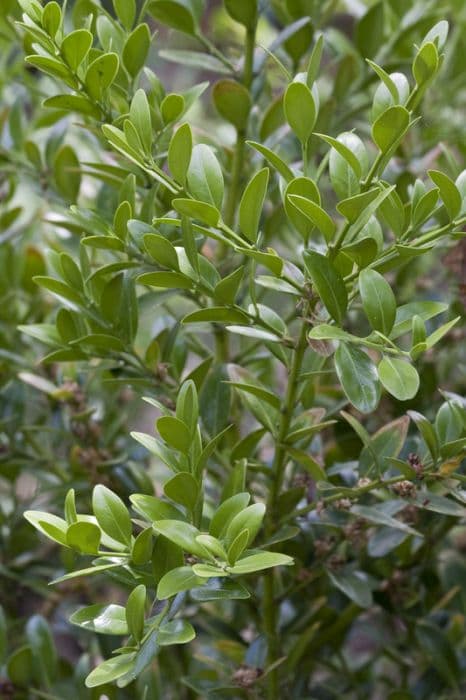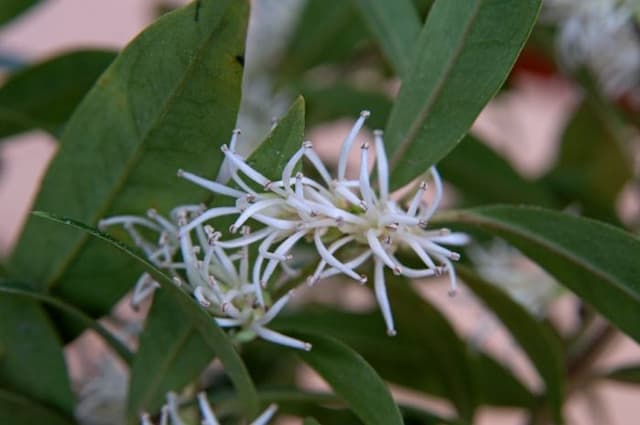Common Boxwood Buxus sempervirens 'Suffruticosa'

ABOUT
Buxus sempervirens 'Suffruticosa', commonly known as the English boxwood, is a dense, small-leafed evergreen shrub. It has a rounded, compact form that makes it a favorite in formal garden settings. The leaves of the English boxwood are glossy, rich green, and somewhat leathery in texture. They are small and oval-shaped, with a rounded tip, and grow in opposite pairs along the stems. The foliage remains green throughout the year, even in the cold of winter, providing a constant display of color in the garden. Throughout the spring, the English boxwood may produce inconspicuous, fragrant yellow flowers, which are typically not a major feature of this plant's appearance. The flowers are small and clustered, and they may attract bees. The bark of the English boxwood is generally smooth with a light brown color. Additionally, the shrub's branches are fine and dense, contributing to its overall bushy appearance that is well-suited for creating low hedges and topiary forms. Without careful pruning, it tends to develop a somewhat mounded shape, lending itself to traditional and manicured garden designs.
About this plant
 Names
NamesFamily
Buxaceae.
Synonyms
Common Box, European Box, Boxwood.
Common names
Buxus sempervirens 'Suffruticosa'.
 Toxicity
ToxicityTo humans
The common boxwood is considered toxic to humans if ingested. The plant contains alkaloids such as buxine which can cause nausea, vomiting, diarrhea, dizziness, and respiratory failure in severe cases. Ingesting parts of the boxwood, particularly the leaves, can also lead to convulsions and potentially be fatal in extreme circumstances. It is advisable to handle the plant with care and ensure it is kept away from children who might accidentally ingest it.
To pets
The common boxwood is also toxic to pets, including cats and dogs. Symptoms of poisoning in pets may include vomiting, diarrhea, drooling, weakness, and seizures. The primary toxic compounds in the plant, such as the alkaloid buxine, can affect the pet's nervous system and gastrointestinal tract. In severe cases, ingestion of the boxwood can be fatal, so it is important to prevent pets from having access to chew or ingest this plant.
 Characteristics
CharacteristicsLife cycle
Perennials
Foliage type
Evergreen
Color of leaves
Green
Height
1-2 feet (30-60 cm)
Spread
1-2 feet (30-60 cm)
Plant type
Shrub
Hardiness zones
5-9
Native area
Europe
Benefits
 General Benefits
General Benefits- Drought Tolerance: Able to survive with minimal watering once established, making it suitable for drier climates or water-conservation landscapes.
- Low Maintenance: Requires only occasional pruning to maintain shape, thereby reducing the need for frequent care.
- Evergreen Foliage: Provides year-round color and structure to gardens with its dense, green leaves.
- Hedge and Border Plant: Commonly used for formal hedges, borders, and topiary, contributing to the structure and design of a garden.
- Deer Resistance: Less appealing to deer, which can benefit gardeners in areas where deer browsing is a problem.
- Shade Tolerance: Can grow well in shaded locations where many other plants would not thrive, increasing landscaping options.
- Soil Adaptability: Adaptable to a wide range of soil types, albeit preferring well-drained conditions.
- Pest Resistance: Shows resistance to many common pests, decreasing the need for pest control measures.
- Cold Hardy: Capable of withstanding cooler temperatures, making it a suitable choice for temperate regions.
 Medical Properties
Medical PropertiesThis plant is not used for medical purposes.
 Air-purifying Qualities
Air-purifying QualitiesThis plant is not specifically known for air purifying qualities.
 Other Uses
Other Uses- Topiary Art: Boxwood is extensively used for topiary, due to its dense foliage and ability to withstand frequent pruning and shaping into various forms such as animals, geometric shapes, and intricate designs.
- Garden Borders: Due to its dense growth habit and ease of pruning, boxwood is ideal for creating well-defined garden borders and hedges, providing structure to garden landscapes.
- Parterre Gardens: Boxwood is commonly used in formal parterre gardens to create low, decorative hedging that outlines patterns and pathways, lending a classic and elegant appearance.
- Woodworking: The wood of boxwood is very hard and fine-grained, making it a valuable material for precision instruments, engraving blocks, and small wooden items like chess pieces.
- Historical Carvings: Boxwood has a rich history of being used for detailed carvings, such as those found in religious artifacts and decorative items from the Renaissance period.
- Focal Point in Container Gardens: When grown in containers, boxwood can be shaped into a variety of forms, serving as a focal point in patio or balcony gardens.
- Winter Garden Interest: Boxwood's evergreen nature provides greenery and structure in the garden during the winter months when most other plants have died back or gone dormant.
- Film and Theater Sets: Boxwood hedges and topiaries are often used in film and theater productions to create stylized or period-appropriate backdrops and settings.
- Living Mazes: Larger varieties of boxwood, when planted in intricate patterns, can form living mazes or labyrinths that are popular attractions in public gardens and parks.
- Photography Props: Boxwood hedges and topiaries are popular as photography props, especially in formal event and wedding photography, to add a touch of classical elegance to the background.
Interesting Facts
 Feng Shui
Feng ShuiThe Boxwood is not used in Feng Shui practice.
 Zodiac Sign Compitability
Zodiac Sign CompitabilityThe Boxwood is not used in astrology practice.
 Plant Symbolism
Plant Symbolism- Everlasting Life: Buxus sempervirens 'Suffruticosa', commonly known as English Boxwood, is an evergreen shrub, symbolizing continuity and immortality because it retains its green leaves throughout the seasons.
- Triumph over Death: In some cultures, the English Boxwood is used in funeral arrangements or planted in graveyards, representing the triumph of the eternal soul over physical death.
- Sturdiness and Reliability: English Boxwood is a hardy plant that can withstand harsh conditions and pruning. This resilience makes it a symbol of dependability and steadfastness in the face of adversity.
- Formality and Order: Its ability to be shaped into precise hedges and borders has historically associated the English Boxwood with gardens of the aristocracy, symbolizing formality, order, and class distinction.
- Fidelity and Stoicism: Given its long lifespan and evergreen nature, the English Boxwood often represents constancy and unwavering character, akin to a loyal and steadfast companion.
 Water
WaterEnglish boxwood should be watered deeply once a week during dry periods without rainfall. Ensure the soil is moist but not soggy, as overwatering can lead to root rot. During the growing season, in the absence of rain, provide approximately 1 to 1.5 gallons per plant each week. Adjust the amount of water during the winter months, as the plant requires less moisture due to slower growth. Always check the soil moisture level a few inches below the surface before watering to avoid overhydration.
 Light
LightEnglish boxwood thrives best in partial shade to full sun conditions. It should be placed in a spot where it can receive at least 4 to 6 hours of sunlight a day. However, it can suffer from leaf scorch in intense, direct afternoon sunlight, so dappled shade is ideal, particularly in hotter climates.
 Temperature
TemperatureEnglish boxwood is hardy and can tolerate a temperature range from about -10°F to 115°F, but it prefers a temperate climate. The ideal temperature range for this plant is between 60°F to 70°F. It is not suited for extreme temperatures on either end of its tolerance spectrum for extended periods.
 Pruning
PruningEnglish boxwood benefits from pruning to maintain its shape and density and to encourage healthy, vigorous growth. Prune in late winter or early spring before the onset of new growth. It can also be pruned in summer to remove any irregular growth. The best time for heavy pruning is late spring, after the risk of frost has passed.
 Cleaning
CleaningAs needed
 Soil
SoilCommon Boxwood prefers well-drained soil with a pH of 6.5-7.5. A mix of two parts loam, one part peat moss or compost, and one part sharp sand is ideal for providing the necessary drainage and fertility.
 Repotting
RepottingCommon Boxwood should be repotted every 2-3 years to refresh the soil and provide room for growth. It is best done in late winter or early spring before new growth starts.
 Humidity & Misting
Humidity & MistingCommon Boxwood thrives in moderate humidity levels but is quite adaptable and can tolerate lower humidity conditions typical of outdoor environments.
 Suitable locations
Suitable locationsIndoor
Provide bright, indirect light and consistent watering.
Outdoor
Plant in well-draining soil with partial to full sun.
Hardiness zone
5-9 USDA
 Life cycle
Life cycleCommon box or boxwood (Buxus sempervirens 'Suffruticosa') begins its life cycle as a seed, which, when sown in well-drained soil and with adequate moisture and temperature conditions, will germinate to give rise to a seedling. Seedlings develop a stout taproot and grow slowly, eventually forming a woody stem and a dense network of fine roots. As the plant matures, it develops its characteristic small, oval, evergreen leaves and can be shaped into a variety of forms through pruning, which is often done when the plant is used as a hedge or for topiary. The mature plant produces small, inconspicuous greenish-yellow flowers in the spring, which are followed by the formation of small, dehiscent capsules containing seeds. Boxwood plants are long-lived and can continue to grow and reproduce for decades, although growth is typically slow and the plant requires minimal maintenance. Over time, older boxwoods may become leggy and may need rejuvenation pruning to maintain their dense, bushy habit.
 Propogation
PropogationPropogation time
Spring to Early Summer
The common boxwood, specifically Buxus sempervirens 'Suffruticosa', is typically propagated through stem cuttings. The best time for taking cuttings is during the late summer to early fall. To propagate by cuttings, one would select a healthy semi-ripe shoot of the current year's growth. The cutting should be about 3 to 4 inches long (approximately 7.5 to 10 centimeters). It's important to make a clean cut just below a leaf node and remove the lower leaves. The top few leaves should be trimmed to reduce moisture loss. Dipping the cut end into rooting hormone can increase the chances of success before the cutting is planted in a well-draining soil mixture. Providing a humid environment by covering the potted cutting with a plastic bag or placing it in a propagator can help to encourage rooting. It normally takes a few weeks for the cuttings to root, after which they can be potted up individually and grown on until ready to plant out.





![Sweet box [Winter Gem]](/_next/image?url=https%3A%2F%2Fplants-admin.emdemapps.com%2Fimages%2Fplants%2F%2Fimages%2F604b6267b442c.png&w=640&q=75)



